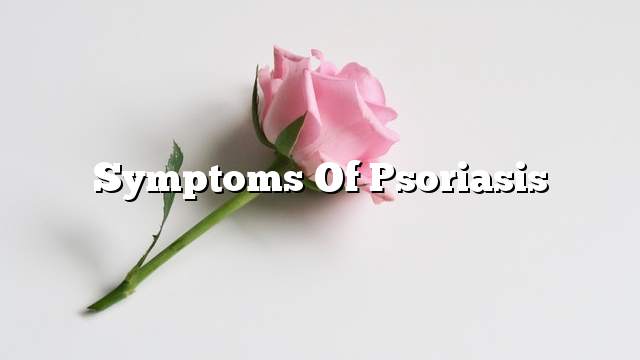Symptoms and signs
Where the disease is divided according to its clinical forms to:
1 – the normal psoriasis (plaque) It is the most common and common, and is in the form of pink spots to clear red with large silver glands in the middle, and vary in size and extend a radius of a few millimeters to several centimeters, which are similar in the area of elbows and knees and the lower back and scalp, Type
2. Guttate psoriasis These are spots that disappear within months, but the normal psoriasis can develop later.
3 – nail psoriasis: They are common, but they can infect one nail or all nails. They appear in the form of pits, which often become thick and yellow, and may lead to nail breakage (nail detachment from the nail casing), and can lead to nail fall.
4- Flexure: It infects the folds under the breasts and the ants and between the thighs in the anesthetic area (anogenital). It is more prevalent in women, the elderly, and in individuals infected with HIV. It is in the form of bright red spots, smooth glaze, often with cracked skin, and is free of crusts.
5- Psoriasis of the feet and feet below (palms and soles): They are red spots with silver scales but are not clear, and the fingers are painful because of cracks.
6 – napkin area napkins (napkin): It spreads beyond the boundaries of the diaper area in infants, and often heals quite quickly, but there is a chance of contracting psoriasis later in life.
7 – pustular psoriasis: And are rare but serious, and are in the form of pustules in the area of redness spread throughout the body, accompanied by pain and high temperature
8 erythrodermic psoriasis: This type is shown as a result of the impact of tar and anthrax and the result of the withdrawal of topical medications such as steroid. The skin in the body is fully and uniformly and uniformly red with different degrees of crust, accompanied by high temperature and a sense of tremor and itching.
Summarize the disease
Psoriasis is a chronic, non-contagious skin inflammation that appears in the form of red spots with silver scales. The most affected areas are the skin of the knees, elbows, the scalp and the lower back area.
2 – The disease spreads in light-skinned people in Europe and North America, the incidence rate is 1-3%, and spread in people aged 15-40.
3. Parents with psoriasis are more likely to transmit the disease to their children than infected mothers
4 – In addition to the genetic factor, there are some factors that stimulate the emergence of psoriasis, including infections and hormones and some medicines and infections (sore throat and AIDS).
5- Psoriasis is divided according to the shape and location of the injury to eight types, namely psoriasis, psoriasis, nail psoriasis, folds, psoriasis, palm rest, psoriasis, psoriasis, psoriasis and redness.
6. The diagnosis of the disease depends on the clinical examination, where the presence of red spots with silver crusts in the spread of the disease.
7. Complications of psoriatic arthritis, secondary infection, increased risk of lymphoma, and increased cerebrovascular disease.
8. Treatment with drugs and radiotherapy includes the use of topical treatment with creams such as cortisone, vitamin D derivatives, A, tar, salicylic acid, radiation therapy such as sun, UVB, oral therapy or injections such as suralin (with UV A), acetretin and methotrexate Cyclosporine and biological materials.
9 – Herbal treatment includes cactus, acetate, red pepper, licorice, fenugreek, walnuts, Brazil, chamomile, the king and other herbs.
1. fitzpatrick’s color atlas and synopsis of clinical dermatology 6th edition
2. Dermatology, Fourth Edition By Richard P.J.B. Weller, John A.A. Hunter, John A. Savin and Mark V. Dahl
3-: //emedicine.medscape.com/
4-herbalremediesworld.com/home-remedies-psoriasis.html
